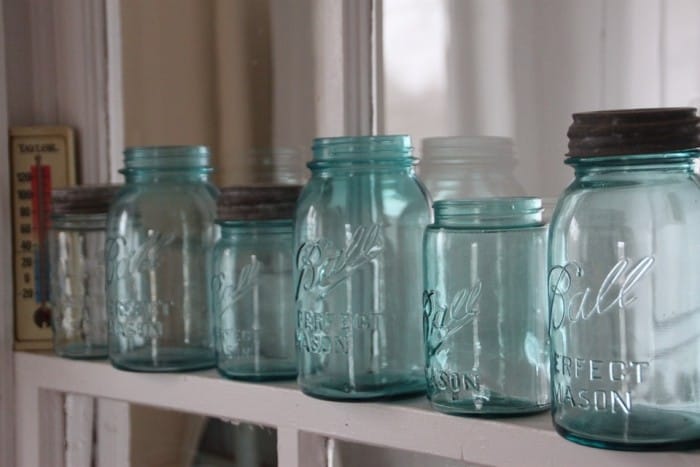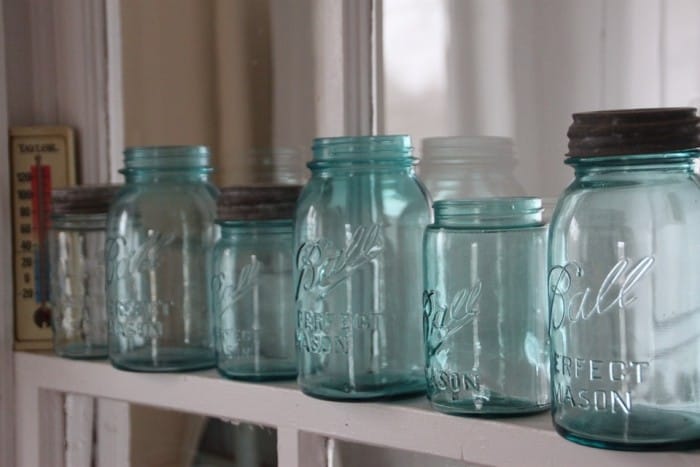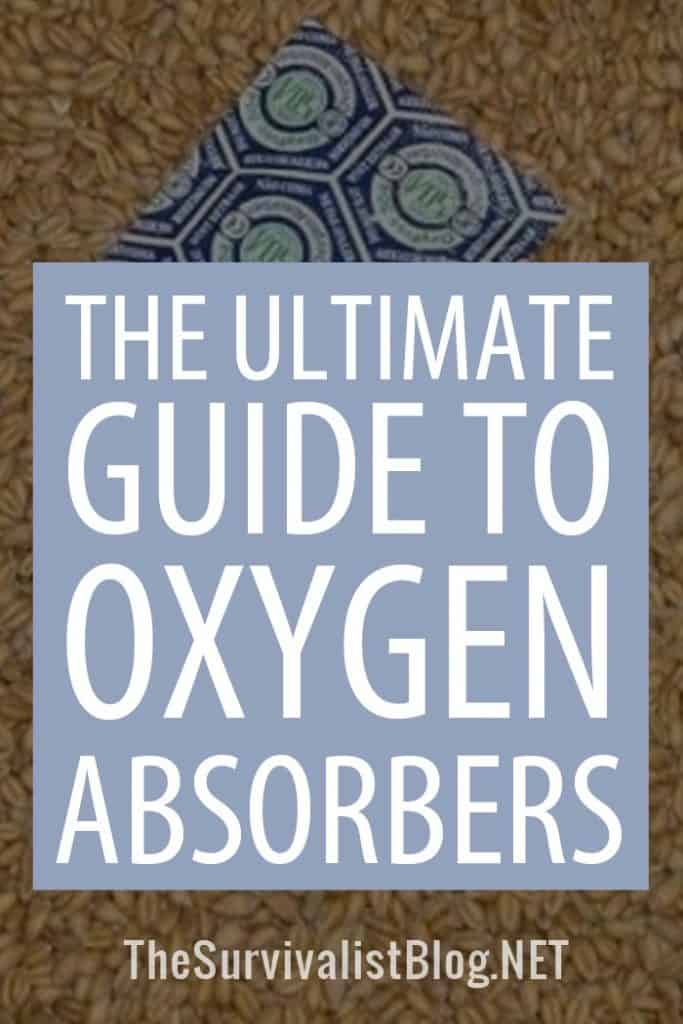The Ultimate Guide to Oxygen Absorbers

In a true emergency, having a substantial stockpile of food is critical for survival. Without food, it’s unlikely that we can survive for more than a few weeks, even in the best of circumstances. So, it’s essential that we have an adequate supply of food in our emergency stores for when SHTF.
Unfortunately, simply having a lot of food in storage is not enough. Indeed, one of the most important things about stockpiling food is storing it properly. If you don’t, all that food that you have in storage can spoil and make you sick when you need it most.
Thankfully, there is a way to extend the shelf life of your food: oxygen absorbers. But, proper use of oxygen absorbers is important if you want to be ready for any eventuality, and a thorough understanding of how they work is critical.
So, to get you started, I’ve put together the ultimate guide to oxygen absorbers, complete with guidance on how to use them properly in your emergency stockpile. Let’s get started.
Table of Contents
What Is An Oxygen Absorber?
Have you ever opened up a box of food or a jar of gummy vitamins and found that they had tiny little packets inside of them?
As a kid, your parents probably immediately took them away and threw them out so you wouldn’t accidentally eat them, but what was in those mysterious-looking packets?
It turns out that those packets are called oxygen absorbers. They are packed into thousands of different commercial food and medical products to help keep them fresh and in good condition while in storage.
Oxygen absorbers help extend the shelf life of many kinds of food, including:
- Nuts and snacks
- Spices
- Flour
- Cookies
- Candy
- Dried fruits
Oxygen absorbers are also used to help increase the shelf life of medications and medical diagnostic kits. You may also find them used in electronics and for the preservation of artwork.
When oxygen absorbers are packaged into food, it’s known as “active packaging.” This means that the container the food is in is actively helping to preserve it and extend its shelf life. Thus, oxygen absorbers are becoming more and more common in long-shelf-life foods.
What Are Oxygen Absorbers Made Of?
Also known as oxygen scavengers, most oxygen absorbers are generally made of small quantities of iron powder that’s mixed with salt. However, some oxygen absorber packets will contain activated carbon instead of iron.
In commercially-made oxygen absorbers, though, what’s in the packet is as important as the packet itself. Most modern oxygen absorbers come in a porous sachet, which allows the packet to remove oxygen from the environment.
However, in some food products, especially those high in fat, these paper sachets are likely to disintegrate, which can be dangerous for human health. So, some oxygen absorbers come in plastic packaging for lasting durability.
How Do Oxygen Absorbers Work?
The idea that a small packet of iron and salt can extend the shelf life of food can be a bit confusing, to say the least. However, the way that oxygen absorbers work is quite cool.
Basically, when you place an oxygen absorber in a container of food, it works to remove the oxygen from that micro-environment. As the oxygen and moisture touch the iron inside the oxygen absorber sachet, the iron oxidizes (a.k.a. rusts) to form iron oxide.
Any salt that’s added to the oxygen absorber simply acts as a catalyst, speeding up the process and allowing the iron to be more effective in dry environments.
As the iron oxide forms, it pulls oxygen out of the micro-environment inside the food container and produces nitrogen.
In fact, oxygen absorbers can reduce the oxygen level inside a sealed container to below 0.01%. If you consider that our atmosphere contains about 20.95% oxygen, this is pretty darn impressive for a little packet of iron.
Ultimately, by removing oxygen from the food container and adding stable nitrogen, the oxygen absorber helps prevent food from spoiling, which extends the shelf life of the food. This makes oxygen absorbers great for use in food storage, especially from a prepper’s perspective.
What Are The Benefits Of Oxygen Absorbers?
It turns out that those tiny little packets inside food containers make a big difference in preserving your food. But what exactly do they do, you might ask? Here are some of the benefits of using oxygen absorbers in a variety of environments:
- Retains the flavor of roasted coffee
- Prevents mold and pathogen growth in cheese and some other dairy products
- Keeps nuts and trail mixes fresh for longer
- Extends the shelf life of spices and seasoned food
- Reduces and delays the browning of fruits and veggies
- Eliminates or reduces the need for other additives, like sorbates
However, it’s important to keep in mind that some foods like sugar and salt, shouldn’t be used with oxygen absorbers because it will cause them to turn rock hard.
Other foods, as we’ve explained, though, can greatly benefit from the use of an oxygen absorber.
What Are The Dangers Of Oxygen Absorbers?
While oxygen absorbers are fantastic little bits of technology, if used incorrectly, they can be dangerous. As we’ve mentioned, in particularly fatty foods, the paper sachets that contain oxygen absorbers can disintegrate.
So, if you’re going to use them with fatty foods, opt for oxygen absorbers with plastic sachets.
Additionally, if you use oxygen absorbers with particularly moist foods, you run the risk of botulism poisoning. The bacteria that causes botulism thrives in moist, low-oxygen environments.
Since botulism is a serious illness that can cause death, prevention is key. Any food that you store with oxygen absorbers should have a moisture content of 10% or less, like rolled oats and dry beans.
How Are Oxygen Absorbers and Silica Gel Different?
If you’ve ever opened up a box containing a new pair of shoes, you’ve probably noticed those small packets that say “Do Not Eat” on them.
These little packets are called silica gels and look quite similar to oxygen absorbers.
However, while silica gel and oxygen absorbers sure do look similar, they are by no means the same thing.
While it’s easy to mistake them for one another, it’s important that you understand the difference between oxygen absorbers and silica gel, especially when it comes to storing your food properly for the long term.
Here’s what you need to know about silica gel:
Silica gel is what’s known as a desiccant, which means it helps remove water from an environment. This makes them different from oxygen absorbers which remove oxygen from an environment.
Modern silica gel packets are filled with tiny balls of silicon dioxide (a.k.a. silica), which is really good at pulling water and moisture from an enclosed space.
You’ll often find silica gel used in products like shoes, purses, electronics, and vitamins because it allows them to be shipped and transported in high humidity conditions without damage.
So, for a prepper, silica gel packets are best used for items like:
- Important documents
- Ammunition cans
- Toolboxes
- Photos
- Medications
- Seeds in storage
If you want to use silica packets for food like jerky and dried fruit, which are quite moist despite being dried, be sure that you buy food-grade packets – not the stuff that you’d find in a box of shoes.
Plus, since silica gel is a choking hazard, you want to be sure that your kids and pets don’t accidentally eat it. So, be sure to remove those silica packets from your food containers before any kids have access to them.
Finally, it’s important to note that you cannot use oxygen absorbers and silica gel together. Since oxygen absorbers need some moisture to function properly, if you remove all of the moisture with silica gel, the oxygen absorbers won’t be able to do their job.
So, it’s best to use one or the other – not both at the same time.
How Do I Use Oxygen Absorbers To Store Food?
At this point, you should have a pretty good understanding of what oxygen absorbers are and what they’re used for. So, up next, we’ll talk about how you can actually use them to extend the shelf life of your food.
What Size Oxygen Absorber Do you Need?
Before you can start storing food with oxygen absorbers, though, you need to buy some. However, there are many different oxygen absorbers available today, so it can be tricky to find the right one for your needs.
Modern oxygen absorbers will come in sizes that range from 20cc to 2000cc. The size of the oxygen absorber refers to the amount of oxygen that they can take out of an environment.
Therefore, a 20cc packet can only remove 20cc of oxygen, while a 200cc packet can take away 200cc of oxygen.
If you do a quick google search, though, you’ll find that there are many different recommendations for the size of oxygen absorber that you need.
In general, you can expect to use one 300cc packet for every gallon of food that you’re looking to store.
However, some food items are denser than others. This means that in a 1-gallon container of flour, for example, you’ll have less air inside than in a 1-gallon container of beans.
So, if you’re looking to store less dense food items, you might want to bump up that guideline to about 400cc of oxygen absorber per gallon.
Keep in mind, though, that there’s really no such thing as adding too many oxygen absorbers. You’ll only really find that you have a problem if you don’t have enough oxygen absorbers for your food.
So, to play it safe, it’s generally best to overestimate your need for oxygen absorbers when you’re packing your food for long-term storage rather than underestimate.
Check out this handy table I made:
| 1 Quart | 1 Gallon | 5 Gallons | |
|---|---|---|---|
| Flour | 50 | 200 | 1000 |
| Dry Milk | 50 | 200 | 1000 |
| Rice | 75 | 300 | 1500 |
| Cornmeal | 75 | 300 | 1500 |
| Oats | 100 | 400 | 2000 |
| Split Peas | 100 | 400 | 2000 |
| Dried Beans (depends on variety) | 150 | 400 – 500 | 2000 – 2500 |
| Pasta (depends on shape) | 150 | 400 – 500 | 2000 – 2500 |
What Should I Store My Food In?
The process of choosing a container to store your food in is incredibly important. But, it’s also quite a complex subject, so we won’t go too in-depth on it here.
However, when it comes to using oxygen absorbers, there are some important things to keep in mind as you choose what to store your food in.
The thing with oxygen absorbers is that they will only work at their best if they are in a truly airtight container.
If a container is not airtight, like a Ziploc bag, your oxygen absorber will absorb as much oxygen as it can, but won’t create an oxygen-free environment since there is air constantly leaking into the container.
So, when storing food with oxygen absorbers, you have two solid options:
Food Grade Plastic Buckets
Food grade plastic buckets are quite a popular method for storing food because they allow you to store food in bulk. Plus, plastic buckets are more or less rodent-proof and are quite durable.
However, plastic buckets on their own do not create a perfectly airtight environment. So, if you do want to use oxygen absorbers, you’ll want to use them in conjunction with mylar bags.
Mylar bags, also known as foil pouches, are great at protecting your food from moisture and light, so they’re great as a second layer of defense for your food inside a plastic bucket.
It’s also a good idea to use gamma lids on your plastic buckets to make them more airtight.

Mason Jars
Mason jars are a fan favorite, especially among people that like to make jams and other preservatives. These glass jars are somewhat affordable and are completely rodent proof.
But, they can break somewhat easily (they are glass!) so Mason jars need to be stored and handled properly. Plus, Mason jars do not protect your food from the light, which means you need to store them in a dark location.
However, Mason Jars are great for creating an oxygen-free environment for your food In addition to using them with oxygen absorbers, you can get a vacuum sealer for Mason jars that is perfect for prepping them for long-term food storage.
Steps For Storing Food With Oxygen Absorbers
So, once you have your food, your containers, and your oxygen absorbers ready, it’s time to start storing your food. Here’s what you want to do:
- Get Your Containers Ready. Before you start, it’s important that all of your containers are completely clean and dry. Have the container lids at the ready so you can immediately seal them when you’re done.
- Prepare Your Food. Fill your containers with the food you’d like to store. Try to fill your containers as much as possible to reduce the amount of air inside.
- Get A Container Ready For The Oxygen Absorbers. If you’ll have any leftover oxygen absorber packets, it’s important that you have an airtight container to store them in. As soon as you open a package of oxygen absorbers, they’ll start to do their thing. The best way to preserve oxygen absorbers is in a vacuum-sealed Mason jar.
- Open The Oxygen Absorber Package. As soon as you open the package of oxygen absorbers, take on out and place it in your first food container. Seal the rest in the mason jar for the moment.
- Seal And Label The Food Container. Once you have an oxygen absorber in your food container, seal it immediately. Label it with the contents and the date of storage so you can have that information for future reference. It’s helpful to have a friend for this step to make you more efficient.
- Repeat Steps 4 And 5. At this point, you can repeat steps 4 and 5 for all of your food containers, making sure to limit the amount of exposure your oxygen absorbers have to a non-airtight environment. Voila! You have successfully stored your food with oxygen absorbers.
What Do I Do With Leftover Oxygen Absorbers?
If you bought your oxygen absorbers in bulk, you may have some leftover packets after you finish storing your food. Since you spent good money on these oxygen absorbers, it’s important that you store them properly or they may go to waste.
Once taken out of their original packaging, oxygen absorbers will only last for about 30 minutes out in the open.
As soon as you’ve finished storing your food, it’s important that you place your oxygen absorbers in an air-tight container. A mason jar that’s vacuum-sealed and stored out of direct sunlight is ideal.
Keep in mind that many oxygen absorbers will come packed with a little pink pill. This pill is used to tell you if the oxygen absorbers are no longer good. If this pill has turned blue, your oxygen absorbers will not work.
So, if you find this pill in the oxygen absorbers’ original packaging, it’s a good idea to place it in their new airtight container. This will make it easier for you to see if your oxygen absorbers are still good to use when you open the container again.
Oxygen Absorber FAQs
Here are our answers to some of your most common questions about oxygen absorbers.
Can You Freeze Oxygen Absorbers?
Generally speaking, oxygen absorbers shouldn’t be used at low temperatures. At low temperatures, the rate of oxygen absorption will be so low that oxygen absorbers just aren’t effective.
So, while they won’t hurt your food, oxygen absorbers simply won’t do much for you at low temperatures.
Why Can An Open Package Of Oxygen Absorbers Feel Warm?
Once you open a new package of oxygen absorbers, you may notice that it feels quite warm. Thankfully, this is nothing to be alarmed about.
The heat is just a result of the oxidizing reaction within all of the oxygen absorbers. To prevent this, seal the unused packets up immediately after opening.
What Happens If You Eat An Oxygen Absorber?
Since oxygen absorbers are usually made with iron, anyone who eats one runs the risk of developing acute iron toxicity.
However, the dose in most oxygen absorbers isn’t enough to cause serious problems in most healthy adults. Children, on the other hand, could become very ill from eating them. Basically, just don’t eat oxygen absorbers, and make sure your kids don’t, either.
Oxygen Absorbers: Critical For Food Storage
If you’re serious about storing food for a long period of time, oxygen absorbers are a must-have. These small packets of iron and salt can greatly extend the shelf life of dry food.
However, it’s important that you understand the dangers of oxygen absorbers and how to use them properly so you can be ready for when SHTF.

